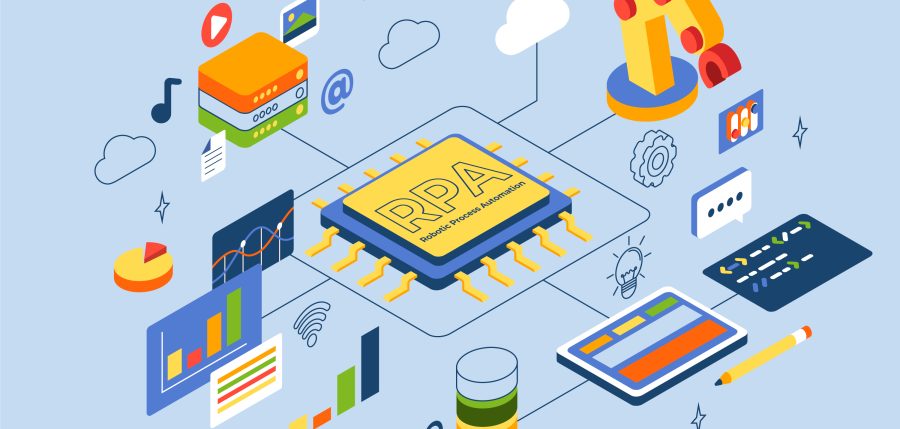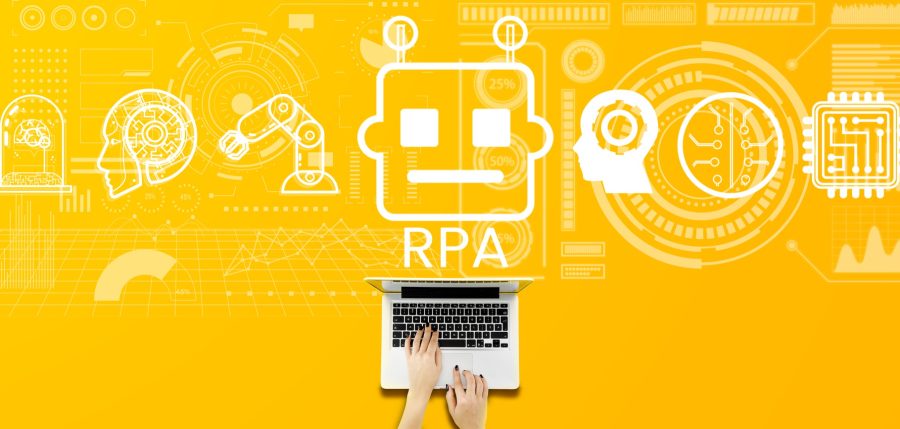
Key takeways
- Payroll processing includes several steps for calculation and disbursement of payments to the employees after a specific payroll period.
- Payroll processing deals with the collection, movement, and delivery of large volumes of sensitive data.
- Technologies such as RPA, AI, ML, etc., have revolutionized how payroll processing functions.
- RPA streamlines the payroll process by identifying patterns, mini- mizing duplicity, and automating repetitive processes.
- Bots provide high-security systems that drastically reduce human errors enabling businesses to manage the process at minimal cost and time.
The terms like Robotic Process Automation or automation make people imagine mechanized robots seen in Sci-fi movies. However, an automation bot is simply software that can be integrated with your existing processes to automate them.
While many organizations are utilizing RPA to automate routine processes, several others have gone a step further and adopted AI-based technologies in conjunction with RPA for better outcomes.
Often the terms Artificial Intelligence and Robotic Process Automation are used interchangeably. However, they are quite different. RPA is a technology that standardizes and automates repeated processes. It works for rule-based processes without learning from the process or getting smarter. On the other hand, Artificial Intelligence is a technology that becomes smarter over time. So, while RPA can automate routine processes such as invoice processing, payroll processing, etc., AI can perform functions like problem-solving, data analytics, and predicting outcomes.
Technologies such as RPA and AI are being successfully implemented to hyper automate multiple processes. One such process is payroll processing.
Payroll processing is one of the critical functions of the HR department. It is a complex process and requires several aspects to be considered. This process is vulnerable to human errors such as miscalculation of payroll, duplication of data, and more because of the large volumes of data being manipulated.
Payroll processing is a series of steps followed for the calculation and disbursement of payments to the employees of an organization after a specific payroll period. This process deals with the collection, movement, and delivery of large volumes of sensitive data.
Step 1: The HR department sets up the payroll schedule and also establishes the dates for payment of taxes.
Step 2: Employee identification number of different employees is listed.
Step 3: Tax Ids of employees are matched with their identification numbers.
Step 4: The financial and tax information of each employee is garnered.
Step 5: The hourly schedules of each employee are tracked.
Step 6: Overtime pay is calculated based on the hourly schedules.
Step 7: Based on the above details the gross pay of the employee is calculated.
Step 8: Various deductions applicable to each employee are assessed.
Step 9: The net pay is calculated as Gross pay minus deductions.
Step 10: The salaries are disbursed to the employees through their preferred mode of payment.
Step 11: A record of payroll is maintained.
Each of these steps requires in-depth data management. An erroneous entry at any of these steps could have severe repercussions. Hence, a high level of accuracy is a vital factor in payroll processing. Since the process is tedious and time-consuming, many organizations outsource it to professional accountants. This can prove to be an expensive option.
The entire process was carried out manually several years ago. But with the advent of computers, the process got streamlined by using spreadsheets, etc. However, working with excel sheets also warrants a lot of manual work.
Drawbacks of manual payroll processing:
- Data like attendance, leave, overtime, etc. need to be captured manually for each employee. At the end of each payroll period, data pertaining to attendance, leave, and overtime has to be manually summarized before processing payroll.
- Maintaining accuracy in payroll processing for a large number of employees is difficult.
- The manual process is slow and requires a lot of people to collaborate and achieve the goals.
Emerging technologies such as RPA, AI, ML, etc., have revolutionized how payroll processing functions. RPA and ML provide high-security systems that drastically reduce human errors. These technologies have enabled businesses to manage the process at high accuracy and at a minimal cost. Besides, RPA bots eliminate human intervention and save a lot of time.
Automation of payroll processing received an impetus during the pandemic and post-pandemic times. This is because several employees were working from different locations and this complicated traditional payroll processing. Automation bots can process payroll even if the employees are located in different countries. They can capture data from any location across the globe and bring it to a centralized platform. Besides, they can process payroll in multiple currencies.
RPA works for rule-based processes that work according to a certain logic. These processes can be automated with the help of bots. Payroll processing works according to a system of set rules and hence can easily be automated.
- The automation software communicates with biometric devices and logs attendance from multiple locations.
- The employee self-service feature enables employees to update their leave data and regularize attendance.
- Attendance, payroll, and leave rules can also be defined in the software. An automated payroll system tracks factors such as overtime, leave balance, entitlements, and more to calculate the payment.
- The RPA bot also assesses the tax due for each employee and prepares the statement for monthly tax payments to the government.
- Based on the above details, payroll is calculated by the software in a quick time without any errors.
- Once the payroll is processed, an automated email system sends email pay slips to all employees.
- Salary transfer to bank accounts of employees is also automated by bots.
- The automation software generates statutory reports relevant to aspects such as bonuses, provident funds, professional tax, and more.
Robotic Process Automation simplifies the payroll process by identifying patterns, minimizing duplicity, and automating repetitive processes thereby streamlining the process. Besides, automation also helps the organization stay updated with local regulations. It provides alerts to the management through automated triggers in case of any discrepancies as well.
Why Must you Implement RPA for Payroll Processing?
Manual payroll processing is time-consuming and tedious. In the manual system of payroll processing, employees need to key in the attendance and leave data of each employee into excel sheets, match the details with an employee identification number, calculate the taxes, etc. RPA simplifies the process and saves time and money.
Manual payroll processing is prone to inaccuracies and human errors. RPA bots can conduct the processing without human intervention. This saves time, speeds up the process, and eliminates inaccuracies.
Payroll processing requires data in the form of attendance and leave records of the employees. So, the staff responsible for the processing will need to wait until the last day of the payroll schedule for data. The processing procedure could take several days after the data is assimilated. This delays the disbursement of salaries. RPA bots pick up the data on the last day and make the required calculations and streamline the disbursement without any delays or errors. Besides, they can incorporate any last-minute changes/entries without delays.
RPA helps establish a single centralized center for payroll processing even though the employees may be located at different geographical locations or working remotely. This simplifies the process and prevents errors and discrepancies.
How does AI complement RPA in Payroll Processing?
- One of the activities associated with payroll processing is resolving the queries of the employees. The individual managing payroll processing usually receives a lot of queries. Answering these queries can take a lot of time. Besides, delays in resolving the queries will not be taken well by the employees. An AI-bot or chatbot can address routine queries instantly. Chatbots also direct the query to the right person in case of complex queries.
- Leveraging RPA for automating payroll processing improves data collection for analysis. AI helps identify data irregularities and recognizes problematic patterns. Based on these factors it helps establish new rules for payroll process automation.
- AI also helps in technical troubleshooting.
- Artificial Intelligence can identify the employees at risk of attrition and send an alert.
Final Words
RPA and AI are technologies that will cause a major shift in the way payroll processing is performed. Implementing these technologies will transform the payroll processing system from an administrative function to a more strategic one. Automation will manage the redundant aspects of payroll processing enabling employees to focus on strategic functions. They will be able to deliver more value to the organization thereby enhancing efficiency, productivity, and compliance.
For the best RPA and AI solutions for your payroll processing connect with the experienced professionals at Auxiliobits. We provide customized bots for seamless functioning of payroll processing in your organization.
Contact Us Now for automation solutions!
Find out more about the processes we automate in our upcoming blogs!





